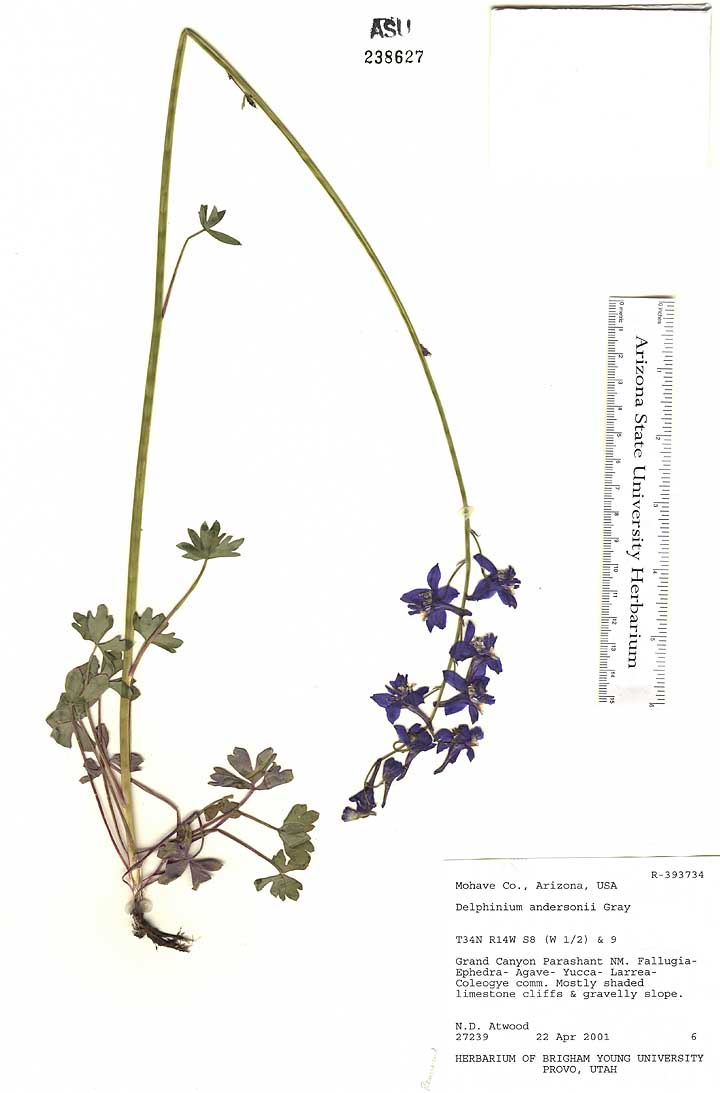
|
Family: Ranunculaceae |
Herbs , perennial, from fasciculate roots or rhizomes. Leaves basal and/or cauline, petiolate, petioles gradually to abruptly shorter on distal leaves; basal leaves usually larger than cauline; cauline leaves alternate. Leaf blade deeply palmately divided, round to pentagonal or reniform, margins entire or lobes apically crenate or lacerate, lobes of basal blades wider and fewer than those of cauline blades. Inflorescences terminal, 2-100(-more)-flowered racemes (occasionally branched, thus technically panicles), 5-40 cm or more; bracts subtending inflorescence branches; pedicels present or absent; bracteoles (on pedicels) subopposite-subalternate, not forming involucre. Flowers bisexual, bilaterally symmetric; sepals not persistent in fruit, 5; upper sepal 1, spurred, 8-24 mm; lateral sepals 2, ± ovate to elliptic, 8-18 mm; lower sepals 2, similar to lateral sepals; upper petals 2, spurred, enclosed in upper sepal, nectary inside tip of spur; lower petals 2, plane, ± ovate, ± 2-lobed, clawed, 2-12 mm, nectary absent; stamens 25-40; filaments with base expanded; staminodes absent between stamens and pistils; pistils 3(-5), simple; ovules 8-20 per pistil; style present. Fruits follicles, aggregate, sessile, ± curved-cylindric, sides prominently veined or not; beak terminal, straight, 2-4 mm. Seeds dark brown to black (often appearing white because of air in seed coat cells), rectangular to pyramidal, often ± rough surfaced. x = 8. Three Eurasian species of Delphinium -- D . elatum Linnaeus, D . grandiflorum Linnaeus, and D . tatsienense Franchet--have been commonly cultivated in North America. Of the nonnative taxa, only D . elatum is sporadically naturalized, as far as is known. Isolating mechanisms in Delphinium appear to be primarily ecological, geographic, and/or temporal. Where these distinctions are disrupted, introgression often exists. Hybridization occurs regularly between certain taxa, particularly in areas of disturbance (e.g., roadcuts, drainage ditches, clearcuts). The more common and easily recognized hybrids are included in the key. Fls irregular; cal corolloid, with unequal sep, the upper one prolonged backward into a spur usually equaling or surpassing the blade; pet mostly 4, the two upper very inequilateral, each with a long spur extending into the spurred sep, the two lower clawed, abruptly deflexed at the middle, often bifid; pet united into 1 in our introduced spp., with 1 spur; stamens numerous; pistils 1-5, the fr follicular; annual or perennial poisonous herbs with basal or cauline, palmately cleft lvs and a terminal, simple or branched raceme of blue to pink or white fls. (Consolida) 200, widespread. Gleason, Henry A. & Cronquist, Arthur J. 1991. Manual of vascular plants of northeastern United States and adjacent Canada. lxxv + 910 pp. ©The New York Botanical Garden. All rights reserved. Used by permission. |
This project was made possible in part by the Institute of Museum and Library Services [MG-70-19-0057-19].
Powered by Symbiota



